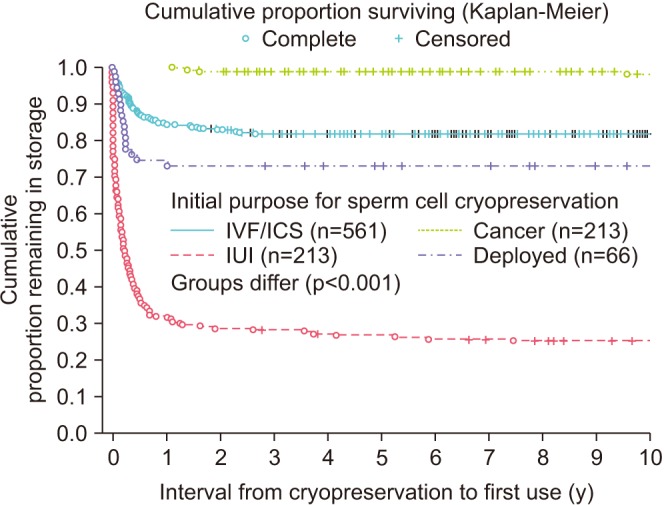1. Bunge RG, Sherman JK. Fertilizing capacity of frozen human spermatozoa. Nature. 1953; 172:767–768.

2. Agarwal A, Tolentino MV Jr, Sidhu RS, Ayzman I, Lee JC, Thomas AJ Jr, et al. Effect of cryopreservation on semen quality in patients with testicular cancer. Urology. 1995; 46:382–389. PMID:
7660514.

3. Brezina PR, Kutteh WH, Bailey AP, Ding J, Ke RW, Klosky JL. Fertility preservation in the age of assisted reproductive technologies. Obstet Gynecol Clin North Am. 2015; 42:39–54. PMID:
25681839.

4. Kelleher S, Wishart SM, Liu PY, Turner L, Di Pierro I, Conway AJ, et al. Long-term outcomes of elective human sperm cryostorage. Hum Reprod. 2001; 16:2632–2639. PMID:
11726587.

5. Saito K, Suzuki K, Iwasaki A, Yumura Y, Kubota Y. Sperm cryopreservation before cancer chemotherapy helps in the emotional battle against cancer. Cancer. 2005; 104:521–524. PMID:
15968690.

6. Pacey A, Merrick H, Arden-Close E, Morris K, Rowe R, Stark D, et al. Implications of sperm banking for health-related quality of life up to 1 year after cancer diagnosis. Br J Cancer. 2013; 108:1004–1011. PMID:
23470465.

7. Girasole CR, Cookson MS, Smith JA Jr, Ivey BS, Roth BJ, Chang SS. Sperm banking: use and outcomes in patients treated for testicular cancer. BJU Int. 2007; 99:33–36. PMID:
17034492.

8. Schover LR, Brey K, Lichtin A, Lipshultz LI, Jeha S. Oncologists' attitudes and practices regarding banking sperm before cancer treatment. J Clin Oncol. 2002; 20:1890–1897. PMID:
11919249.

9. Sheth KR, Sharma V, Helfand BT, Cashy J, Smith K, Hedges JC, et al. Improved fertility preservation care for male patients with cancer after establishment of formalized oncofertility program. J Urol. 2012; 187:979–986. PMID:
22264454.

10. Johnson MD, Cooper AR, Jungheim ES, Lanzendorf SE, Odem RR, Ratts VS. Sperm banking for fertility preservation: a 20-year experience. Eur J Obstet Gynecol Reprod Biol. 2013; 170:177–182. PMID:
23870186.

11. Chung K, Irani J, Knee G, Efymow B, Blasco L, Patrizio P. Sperm cryopreservation for male patients with cancer: an epidemiological analysis at the University of Pennsylvania. Eur J Obstet Gynecol Reprod Biol. 2004; 113(Suppl 1):S7–S11. PMID:
15041122.

12. Magelssen H, Haugen TB, von Düring V, Melve KK, Sandstad B, Fosså SD. Twenty years experience with semen cryopreservation in testicular cancer patients: who needs it? Eur Urol. 2005; 48:779–785. PMID:
15963629.

13. Ping P, Gu BH, Li P, Huang YR, Li Z. Fertility outcome of patients with testicular tumor: before and after treatment. Asian J Androl. 2014; 16:107–111. PMID:
24369141.

14. Menon S, Rives N, Mousset-Siméon N, Sibert L, Vannier JP, Mazurier S, et al. Fertility preservation in adolescent males: experience over 22 years at Rouen University Hospital. Hum Reprod. 2009; 24:37–44. PMID:
18945713.

15. Cressman BE, Pace-Owens S, Pliego JF, Wincek TJ, Kuehl TJ. Effect of sperm dose on pregnancy rate from intrauterine insemination: a retrospective analysis. Tex Med. 1996; 92:74–79. PMID:
8979764.
16. Anger JT, Gilbert BR, Goldstein M. Cryopreservation of sperm: indications, methods and results. J Urol. 2003; 170:1079–1084. PMID:
14501696.

17. Ferrari S, Paffoni A, Filippi F, Busnelli A, Vegetti W, Somigliana E. Sperm cryopreservation and reproductive outcome in male cancer patients: a systematic review. Reprod Biomed Online. 2016; 33:29–38. PMID:
27156003.

18. Wu AK, Odisho AY, Washington SL 3rd, Katz PP, Smith JF. Out-of-pocket fertility patient expense: data from a multicenter prospective infertility cohort. J Urol. 2014; 191:427–432. PMID:
24018235.

19. Pastuszak AW, Lai WS, Hsieh TC, Lipshultz LI. Posthumous sperm utilization in men presenting for sperm banking: an analysis of patient choice. Andrology. 2013; 1:251–255. PMID:
23315967.








 PDF
PDF ePub
ePub Citation
Citation Print
Print




 XML Download
XML Download